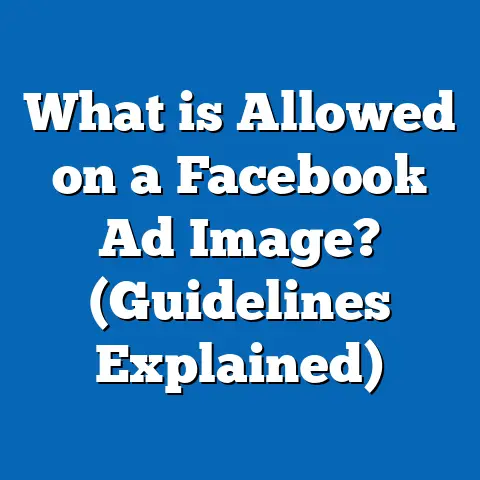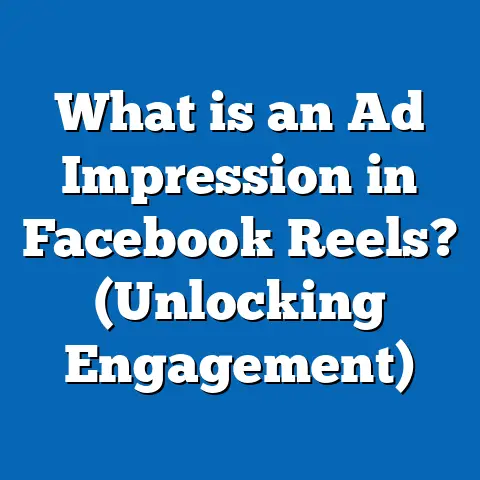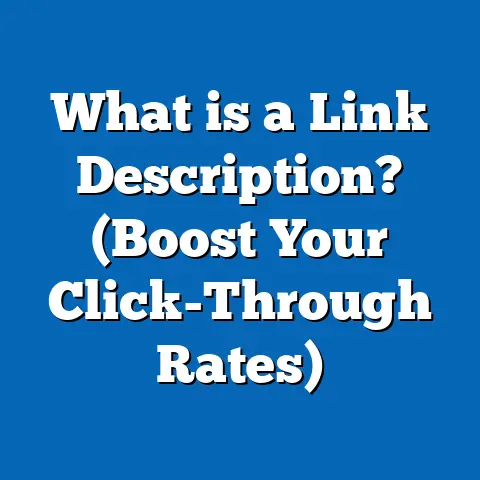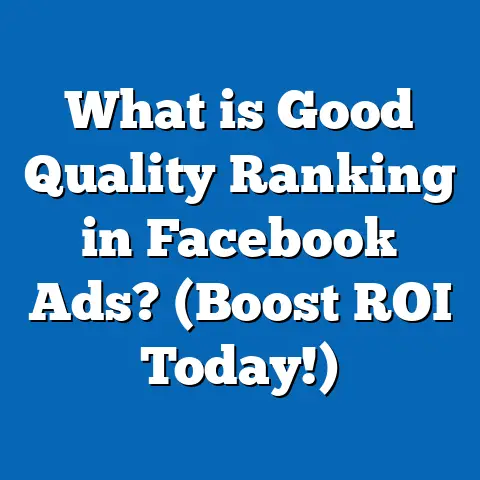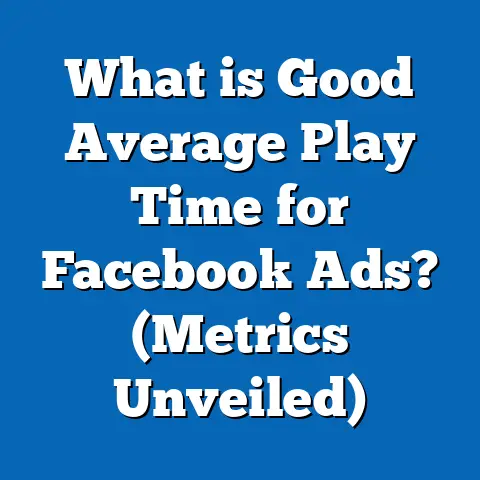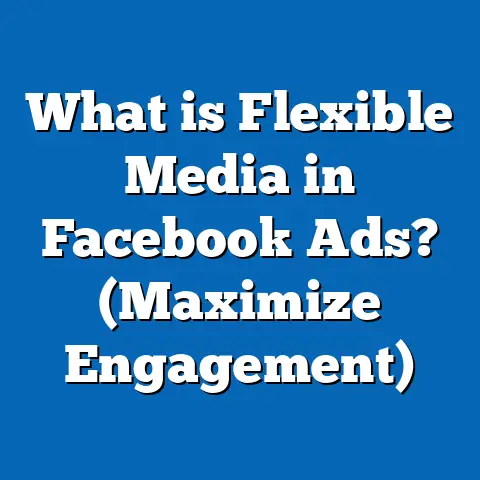What is Auction Buying in Facebook Ads? (Boost Your ROI!)
Introduction: Unlocking Facebook Ads’ Full Potential Through Auction Buying
In the rapidly evolving world of digital advertising, businesses face a common challenge: how to maximize return on investment (ROI) while navigating complex ad platforms. Facebook Ads, with its vast reach and sophisticated targeting, offers immense opportunities — but only if marketers understand how to leverage its auction buying system effectively. Many advertisers waste budget or underperform simply because they don’t grasp how Facebook’s auction works and how to optimize their bids and strategies accordingly.
This guide dives deep into Auction Buying in Facebook Ads, demystifying how it functions, why it matters, and how you can use it to boost your campaign performance dramatically. Whether you’re a marketing professional or a business owner, mastering this concept will empower you to make smarter decisions, improve ad delivery, and ultimately increase your ROI.
What is Auction Buying in Facebook Ads?
Understanding the Basics of Facebook’s Auction System
Facebook Ads operates on an auction model where advertisers compete for ad placements. Unlike a traditional fixed-price system, Facebook’s auction dynamically determines which ads get shown and at what cost, based on multiple factors.
- Auction participation: Every time there is an opportunity to show an ad to a user, an auction takes place.
- Advertisers bid: Advertisers submit bids indicating how much they’re willing to pay for their ads to be shown.
- Winner selection: Facebook selects the winning ad not just based on the highest bid but by balancing bid amount, estimated action rates (likelihood of user engagement), and ad quality.
This system ensures users see relevant ads while advertisers get value for their spend.
Key Components of the Auction
Let’s break down the auction mechanism into its essential components:
- Bid Amount
This is the maximum amount you’re willing to pay for your ad to be shown or for a specific action (like a click or purchase). Bids can be automatic or manual. - Estimated Action Rates
Facebook uses historical data and machine learning to predict how likely a user is to take the action you want (such as clicking your ad or making a purchase). Higher estimated action rates increase your chances of winning auctions. - Ad Quality
Measured through user feedback, engagement rates, and relevance scores — Facebook prefers showing ads that users find useful or enjoyable.
Together, these factors create a Total Value score that Facebook uses to select which ad wins the auction.
Why Auction Buying Matters for Your Facebook Ads ROI
The Problem: High Costs and Low Returns Without Auction Insight
Many advertisers treat Facebook Ads like a simple pay-per-click platform, focusing only on bids or budgets without understanding auction dynamics. This often leads to:
- Overspending due to inefficient bidding.
- Poor ad placement resulting in low engagement.
- Failure to reach the most valuable audience segments.
- Campaigns that deliver impressions but fail conversions.
Facebook’s auction model means the highest bidder doesn’t always win — so blindly increasing bids without strategy wastes money.
The Solution: Optimizing Auctions to Increase ROI
By mastering auction buying:
- You pay less for higher-quality impressions.
- Your ads reach users more likely to convert.
- Campaigns become more cost-efficient and scalable.
- You gain competitive advantage through smarter bidding and targeting.
Data Point:
According to Facebook’s internal benchmarks, advertisers who actively optimize bids based on auction behavior see up to 30% better cost per action (CPA) compared to those relying solely on automatic bidding.
A Word from Industry Research:
A study by AdEspresso analyzed over 10,000 Facebook campaigns and found that manual bid strategies combined with audience segmentation improved ROAS by an average of 35% compared to default bid settings.
How Facebook’s Auction Works Step-by-Step
Step 1: Advertiser Sets Goals and Budget
You start by defining your campaign objective — such as awareness, traffic, lead generation, or conversions. Then you set your budget limits, either daily or lifetime.
Step 2: Advertiser Chooses Bid Strategy
Facebook offers several bidding options:
- Lowest Cost (Automatic): Facebook bids automatically to get the most results within your budget.
- Cost Cap: Limits average cost per result while maximizing volume.
- Bid Cap: You set the maximum bid; Facebook won’t bid higher than this.
- Target Cost: Aims for stable costs near your target across the campaign.
Each strategy affects how aggressive your bids are in auctions.
Step 3: Facebook Enters Auction When Ad Space Opens
Whenever a user scrolls their feed or visits a site in Facebook’s Audience Network, an opportunity arises for an ad impression. Eligible ads targeting that user enter an auction.
Step 4: Facebook Calculates Total Value for Each Ad
Facebook calculates the total value using this formula: Total Value=Bid×Estimated Action Rate+Ad Quality Score\text{Total Value} = \text{Bid} \times \text{Estimated Action Rate} + \text{Ad Quality Score}
This means even if your bid isn’t the highest, superior ad quality and relevance can win auctions at lower costs.
Step 5: Winning Ad Gets Displayed & Advertiser Pays
The winning advertiser pays just enough to beat the next highest total value — this is known as a second-price auction. This model prevents overpaying and encourages competitive bidding.
Deep Dive into Bid Strategies & Their Impact
Lowest Cost (Automatic Bidding)
- Automatically adjusts bids to spend your budget efficiently.
- Ideal for campaigns focused on volume rather than strict cost control.
- Can result in fluctuating CPA depending on competition.
Example: A small business wanting to maximize clicks within a $20/day budget may benefit from this strategy.
Cost Cap
- Controls average CPA but allows some bidding flexibility.
- Balances volume and cost control.
- Useful when you want predictable spending but still want scale.
Data Insight: Advertisers using cost cap bidding report 15-20% more stable CPAs over time compared to lowest cost bidding.
Bid Cap (Manual Bidding)
- You set the maximum amount you’re willing to bid per impression or action.
- Offers full control but needs constant monitoring.
- Risk of limited delivery if bids are set too low or overspending if too high.
Use Case: Experienced advertisers running retargeting campaigns with a clear CPA goal can benefit from bid cap control.
Target Cost
- Focuses on maintaining consistent CPA around a target.
- Best for campaigns requiring steady returns.
- Less flexible when market competition changes rapidly.
Case Study: How Auction Buying Boosted ROI for an E-commerce Brand
Background
An online retailer selling athletic apparel faced rising costs and stagnant sales through Facebook Ads.
Challenge
- High CPAs with automatic bidding.
- Broad audience targeting leading to wasted impressions.
- Low engagement rates on creatives.
Approach
- Switched from lowest cost to cost cap bidding with a CPA target of $20.
- Segmented audiences by behavior: retargeting website visitors vs new lookalike audiences.
- Created tailored creatives per segment focusing on product benefits and testimonials.
- Implemented Campaign Budget Optimization (CBO) for better budget allocation.
Results After 3 Months
| Metric | Before Auction Optimization | After Optimization | Improvement |
|---|---|---|---|
| Cost Per Purchase (CPA) | $25 | $18 | -28% |
| Return on Ad Spend (ROAS) | 2.5x | 4.0x | +60% |
| Conversion Rate | 1.8% | 3.2% | +78% |
The brand lowered acquisition costs while increasing revenue through smarter auction bidding and better ad relevance.
Common Misconceptions About Facebook’s Auction Buying
Misconception 1: Highest Bid Always Wins
Facebook prioritizes total value — including estimated action rates and ad quality — not just bid amount. Low-quality ads often lose auctions even with high bids.
Misconception 2: Manual Bidding Is Always Better
Manual bidding provides control but requires expertise. Poorly managed manual bids can reduce delivery or increase costs unnecessarily. Automated bidding has improved greatly with machine learning.
Misconception 3: Increasing Budget Always Improves Results
Without optimizing bids and targeting, increasing budget may spread your campaign thinly over less valuable impressions, leading to diminishing returns.
How to Optimize Your Facebook Auction Strategy: Practical Tips
1. Focus on Ad Quality and Relevance
High-quality ads improve estimated action rates and relevance scores, helping you win auctions at lower costs.
- Use engaging visuals and clear messaging.
- Test different formats like video, carousel, or stories.
- Monitor feedback metrics like CTR, negative feedback, and conversion rates.
2. Use Campaign Budget Optimization (CBO)
CBO lets Facebook automatically distribute your budget across ad sets based on real-time performance at auction level.
- Helps find best-performing segments without manual reallocation.
- Reduces micromanagement and improves efficiency.
3. Segment Audiences Wisely
Tailor bids and creatives per audience segment for precise targeting:
- Retarget website visitors with higher bids.
- Use lookalike audiences for prospecting with moderate bids.
- Exclude low-value segments that drain budget without conversions.
4. Choose the Right Bid Strategy Based on Goals
Match bidding strategy with campaign objectives:
| Goal | Recommended Bid Strategy |
|---|---|
| Maximize volume | Lowest Cost |
| Control CPA | Cost Cap or Target Cost |
| Full bid control | Manual Bid Cap |
Experiment with strategies during campaign setup and analyze results carefully.
5. Monitor Auction Insights Regularly
Use Facebook’s Auction Insights reports to:
- See competition levels in your target audience.
- Understand impression share lost due to bid or budget constraints.
- Adjust bids or budgets where auction competition is highest.
Understanding Auction Insights Reports in Detail
Facebook provides an Auction Insights tool that shows detailed information about how your ads compete in auctions:
| Metric | What It Means |
|---|---|
| Impression Share | Percentage of auctions your ads won |
| Lost Impression Share – Bid | Percentage lost due to insufficient bid |
| Lost Impression Share – Budget | Percentage lost due to limited budget |
| Average Position | Typical placement rank your ads receive |
Using this data helps pinpoint if low delivery is due to low bids or budget caps, enabling targeted optimization actions.
Comparing Facebook’s Auction System with Google Ads’ Auction
| Feature | Facebook Ads Auction | Google Ads Auction |
|---|---|---|
| Auction Model | Second-price auction focusing on total value | Second-price auction primarily based on CPC bids |
| Factors Influencing Wins | Bid, Estimated Action Rate, Ad Quality | Bid, Quality Score (CTR, landing page experience) |
| User Targeting Granularity | Highly detailed demographic & interest-based targeting | Primarily keyword-based targeting |
| Bid Control Options | Multiple bid strategies (lowest cost, cost cap) | Manual CPC, Enhanced CPC, Target CPA |
| Primary Ad Formats | Social feed ads, stories, video | Text ads, shopping ads |
Both platforms use auctions but differ in targeting methods and bid controls suited to their audience behavior.
Advanced Techniques for Auction Optimization
Leveraging First-party Data for Higher Auction Wins
Integrating customer data like email lists or website visitors into Facebook’s Custom Audiences boosts estimated action rates. Personalized targeting signals higher relevance in auctions.
Dynamic Creative Optimization (DCO)
Using DCO tools lets you automatically test multiple creative elements (images, headlines) within one ad set. This improves ad quality scores by identifying the best-performing combinations quickly.
Bid Multipliers by Placement & Device
Adjust bids by placement type (feed vs stories) or device (mobile vs desktop) based on performance differences. For example:
- Increase bids for mobile placements if conversion rates are higher there.
- Lower bids on underperforming placements.
Leveraging Automatic Rules for Bid Management
Set up rules in Ads Manager that automatically adjust bids based on CPA thresholds or delivery pace to maintain optimal bidding without manual intervention daily.
Real World Applications: Examples Across Industries
E-commerce Brands
Auction buying helps:
- Lower CPAs by targeting high-intent shoppers.
- Scale prospecting campaigns using lookalikes with controlled bids.
- Retarget cart abandoners with higher bid caps for conversions.
SaaS Companies
Using cost cap bidding with lead generation objectives keeps predictable CPL (cost per lead) while maximizing qualified signups via segmented audiences.
Local Businesses
Local businesses benefit from auction insights by adjusting bids during peak business hours or days when conversion likelihood is higher — optimizing budget spend efficiently.
Latest Trends in Facebook Auction Buying (2024 Update)
- AI-driven Bid Optimization:
Facebook increasingly uses AI models that adjust bids in real-time beyond manual settings for better auction competitiveness. - Ad Experience Weighting:
User feedback metrics like “hide ad” or “report” have stronger influence in auctions to improve overall platform user satisfaction. - Privacy Changes Impact:
Post iOS14+ privacy updates emphasize first-party data use and aggregated event measurement affecting auction signals and requiring new attribution strategies. - Hybrid Bidding Models:
New features combining cost caps with volume scaling allow advertisers better control without sacrificing delivery pace.
Summary & Next Steps: Mastering Auction Buying for Better Results
Understanding Facebook’s auction buying system is crucial for running effective campaigns that maximize ROI. Key takeaways:
- The auction balances bid amount, user engagement likelihood, and ad quality — not just who bids highest.
- Choosing the right bid strategy based on your campaign goals can reduce costs and improve results.
- Continual testing and optimization are necessary due to dynamic auction conditions.
- Combining quality creatives with targeted audiences increases your chances of winning auctions efficiently.
- Monitor platform changes and adapt strategies accordingly in response to evolving trends and privacy shifts.
To implement these insights:
- Review your current campaigns’ bidding strategies.
- Experiment with cost cap or target cost bidding if using automatic bids only.
- Invest in improving ad relevance through creative testing and audience segmentation.
- Use data-driven decision making via Auction Insights reports regularly.
- Stay updated with new platform features and industry best practices.
Mastering auction buying turns Facebook Ads from a budget drain into a powerful growth engine capable of delivering sustained business success.
If you want help analyzing your current campaigns or creating custom optimization plans based on these principles, I’m here to assist further!
Appendix: Glossary of Key Terms
| Term | Definition |
|---|---|
| Auction | The process where Facebook selects which ad gets shown. |
| Bid | The maximum amount offered for an ad impression or action. |
| Cost Cap Bidding | Bid strategy that limits average cost per result. |
| Estimated Action Rate | Prediction of how likely a user will perform desired action. |
| Second-price Auction | Winner pays just enough to beat second-highest total value. |
| Campaign Budget Optimization (CBO) | Automatic budget distribution among ad sets based on performance. |
Additional Resources
- Facebook Business Help Center – Auctions
- AdEspresso Guide – Facebook Ads Bidding Strategies
- WordStream – Understanding Facebook Ad Auctions

